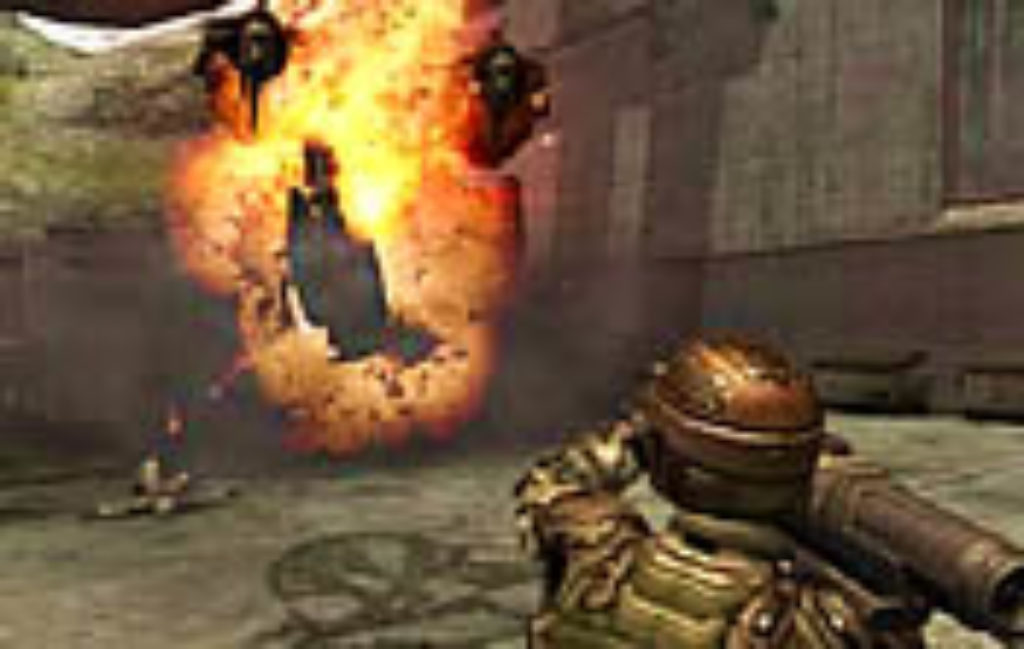
In the late 1990s first-person shooters such as Doom and Quake were hitting their stride and urging fans to team up with their buds in multiplayer deathmatches and war-games. Hard-core gamers roamed vast futuristic terrains while dreaming up intricate strategies to outflank, outsmart and out-slaughter their enemies. Console gamers, who didn’t own a smokin’ PC with all the high-tech bells and whistles, were (sometimes unwillingly) kept at a safe distance from the M-rated Armageddon.
But a lot has changed in 10 years.
For one thing, M-rated bloodletting is now, unfortunately, pretty common in the next-gen console gaming world. And Enemy Territory: Quake Wars, the fifth rendition of the popular Quake franchise, has, for the first time, been ported over to Sony’s PlayStation 3 and Microsoft’s Xbox 360. Ironically, it’s not rated M: It’s a T.
A Story Only a Gamer Could Love
The Quake saga is pretty simple. In the year 2065, scientists begin experimenting with a teleportation technology called a Slipgate. But an unexpected enemy uses that portal to attack mankind.
That’s it. That’s all the story you’re gonna get. And to be honest, if you didn’t do a little homework online, you wouldn’t even know that much. Quake Wars keeps the details to itself. It simply hands you a digital rifle and shoves you out the helicopter door. No instructions or tutorials, either. This is war, soldier. You don’t need no stinking tutorials!
Like the rest of the franchise, this is essentially a class-based tactical shooter. In a way, it’s strategically kind of like chess … only with rocket launchers. Teams are made up of five different types of characters: 1) aggressive, gun-blazing soldiers, 2) healing medics, 3) engineers who repair and disarm things, 4) field ops who deploy artillery and missile systems, and 5) covert ops who sneak around, snipe at enemies and deploy radar.
This interdependent squad fights on 12 sizable frontiers and battles to overcome opponents and complete time-sensitive objectives¬. Missions include such things as defending a bridge, securing and transmitting valuable enemy intel and constructing an offensive laser. Of course, you’ve got to have something to fight for, so gamers can either wave the flag of the human Global Defense Force or dig in as the alien Strogg—”soulless” fusions of decaying flesh, bone and metal that have deadly weapons attached where their hands should be.
A variety of vehicles such as four-wheelers, tanks and alien jet packs help you make your way through the front lines. And when you toss in alien mech-creatures that strafe the battlefield, and missile and laser air strikes that constantly rain from the skies, you’ve got yourself a pretty active war zone.
Live to Die. And Then Die Again.
You’ve also got an extremely fast-paced and complex game. A game that’s particularly challenging because, ultimately, it’s all about online play with up to 16 local or worldwide gamers. And while you’re not given any instruction on how to accomplish your varied missions, you are supplied with an offline single-player version of the game—complete with the same jungle/city/desert landscapes—that you can crash around and die repetitively in (at the hand of AI opponents) until you feel ready to face the real guys online.
Most gamers will need a good eight to 10 hours of offline play just to gain the basic skills and XP (experience points) needed to compete online—and that’s on the easiest setting and at the lowest rankings. That’s a lot of time spent just getting ready to play.
And let me wave the yellow flag about something else, while I’m at it. In spite of the fact that Quake Wars has staunched its blood flow in order to earn a teen-friendly rating, there are still dangers here:
The offline game limits profanity to sporadic interjections of “h—” and “d–n.” “Fix the d–n generator,” for example, can echo over the com. But online, once gamers plug in with their headsets and mics, there are no such verbal limits in the heat of battle.
Likewise, the T on the cover means the gore is gone, but the goal of mowing down masses of meanies remains the same. Gamers are essentially playing levels over and over in an attempt to develop intricate combat tactics and learn all the corresponding terminology. In other words, there’s a whole lot of repetitive trigger pulling going on. And that immediately makes me think about what can happen when someone spends hours and hours blowing (fake) people away:
“We know a lot about how to be an effective teacher, and we know a lot about how to use technology to teach,” said Iowa State assistant professor of psychology Douglas Gentile, who co-authored a video game study of several thousand grade schoolers and teens. “Video games use many of these techniques and are highly effective teachers. So we shouldn’t be surprised that violent video games can teach aggression.”
Gentile’s study showed that, even when controlling for age, race, sex and prior aggressive behaviors, students who played multiple violent games were 263% more likely to act aggressively (as rated by peers and teachers) than those who only played nonviolent games.
So while Enemy Territory: Quake Wars stays light-years away from the gushing gore and guts of Gears of War—or even older Quake games—it’s still a shooter. A point-and-blast distraction that flaunts a field of battle filled with land mines.

After spending more than two decades touring, directing, writing and producing for Christian theater and radio (most recently for Adventures in Odyssey, which he still contributes to), Bob joined the Plugged In staff to help us focus more heavily on video games. He is also one of our primary movie reviewers.